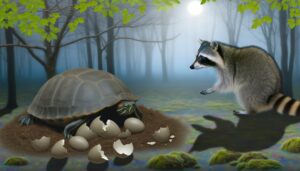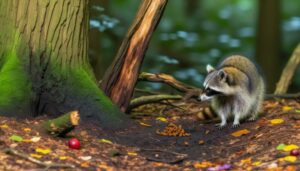How Do Raccoons Eat Your Field Corn?
Yes, raccoons do eat field corn. As omnivorous mammals, raccoons possess a highly varied diet that includes fruits, nuts, insects, and small vertebrates.
Field corn, or Zea mays, with its high starch and carbohydrate content, serves as an energy-dense food source, especially appealing to raccoons. Its abundance in agricultural settings increases its attractiveness, particularly during the summer when it's readily accessible.
These aspects of raccoon dietary habits notably influence their foraging behaviors and preferences. Understanding their dietary needs and seasonal feeding habits provides further insights into managing raccoons in agricultural environments.
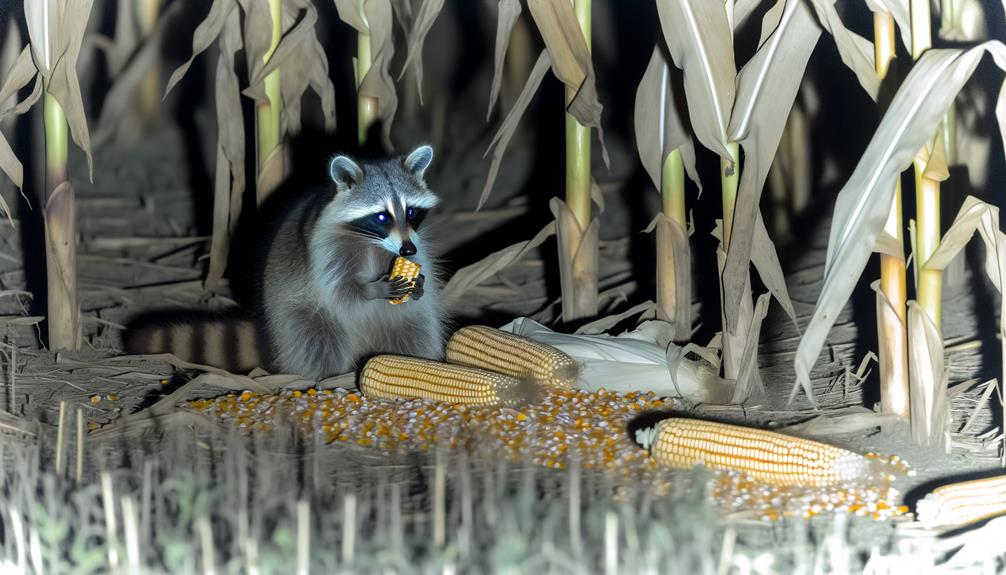
Key Takeaways
- Raccoons eat field corn, especially during summer when it is readily accessible.
- Field corn's high carbohydrate and starch content makes it an appealing energy-dense food source for raccoons.
- Raccoons' omnivorous diet includes a wide range of foods, making field corn a suitable option.
- Agricultural settings with abundant field corn attract raccoons due to its availability and nutritional value.
- Opportunistic feeding habits of raccoons lead them to consume field corn when other food sources are less accessible.
Raccoon Diet Overview
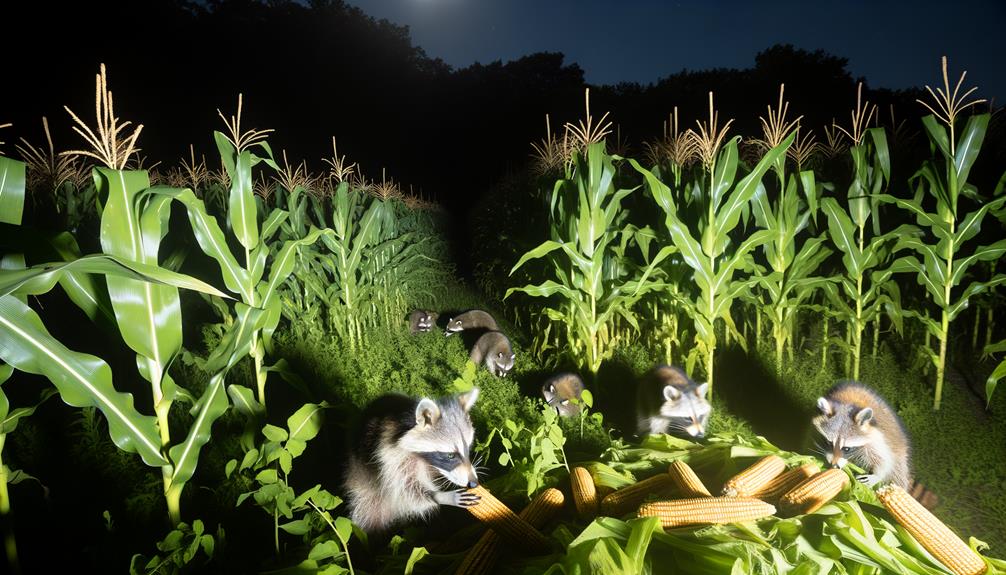
Raccoons (Procyon lotor) are omnivorous mammals with a highly adaptable and varied diet that includes both plant and animal matter. Their dietary habits demonstrate remarkable flexibility, allowing them to thrive in diverse environments.
Observational studies have documented raccoons consuming fruits, nuts, seeds, and berries, highlighting their reliance on seasonal availability. Additionally, raccoons are known to prey on small animals such as insects, amphibians, and fish, illustrating their opportunistic feeding behavior.
Human settlements also provide additional food sources, including garbage and pet food, which raccoons readily exploit. This dietary versatility not only supports their survival across different habitats but also underscores their role as both predators and scavengers within ecosystems.
Understanding their diet is essential for managing raccoon populations effectively.
Nutritional Needs of Raccoons
Understanding the nutritional needs of raccoons is vital for comprehending their dietary preferences and overall health. Raccoons are omnivorous creatures that require a balanced intake of proteins, fats, and carbohydrates. Their diet typically includes fruits, nuts, insects, and small vertebrates, ensuring they obtain essential amino acids, vitamins, and minerals.
Carbohydrates, primarily sourced from fruits and grains, provide necessary energy. Fats, sourced from animal prey and seeds, aid in maintaining their metabolic functions and energy reserves. Proteins, essential for growth and tissue repair, are obtained from both plant and animal sources.
Seasonal variations in food availability also influence their nutritional intake, necessitating a diverse diet to meet their physiological demands. Understanding these needs is vital for evaluating their food choices, such as field corn.
Field Corn Characteristics
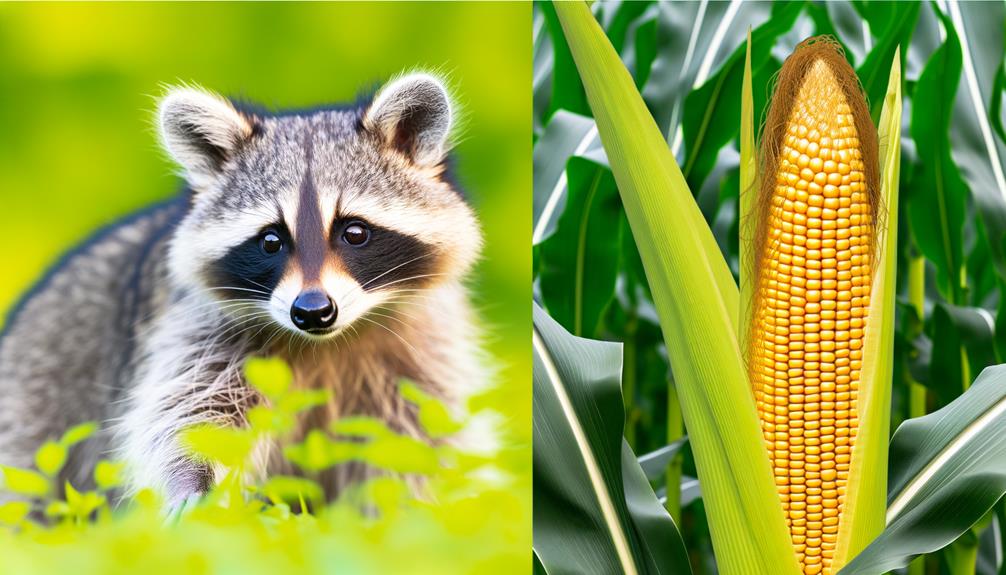
Given the diverse dietary requirements of raccoons, it is pertinent to examine the characteristics of field corn to determine its suitability as a food source. Field corn, scientifically classified as Zea mays, is typically grown for livestock feed, ethanol production, and processed food ingredients. It differentiates from sweet corn with its higher starch and lower sugar content, leading to a tougher, less palatable taste for humans.
The kernels are encased in a strong husk and supported by a robust stalk, growing in large ears. Nutritionally, field corn is rich in carbohydrates, particularly starch, with moderate protein and low-fat content. These attributes underscore its potential as an energy-dense food source for various wildlife, including raccoons.
Why Raccoons Love Corn
Despite the tougher texture and lower sugar content of field corn compared to sweet corn, its high carbohydrate and starch levels make it an appealing energy source for raccoons. These animals require substantial energy to sustain their active foraging and adaptive behaviors. The dense nutritional profile of field corn provides a readily available fuel that supports their metabolic needs.
Additionally, raccoons are equipped with dexterous front paws, allowing them to easily manipulate and consume the corn kernels. Observations indicate that raccoons are opportunistic feeders, often selecting food sources that maximize their caloric intake. Field corn's abundance in agricultural settings further enhances its attractiveness, providing raccoons with easy access to this high-energy food source.
Seasonal Feeding Habits
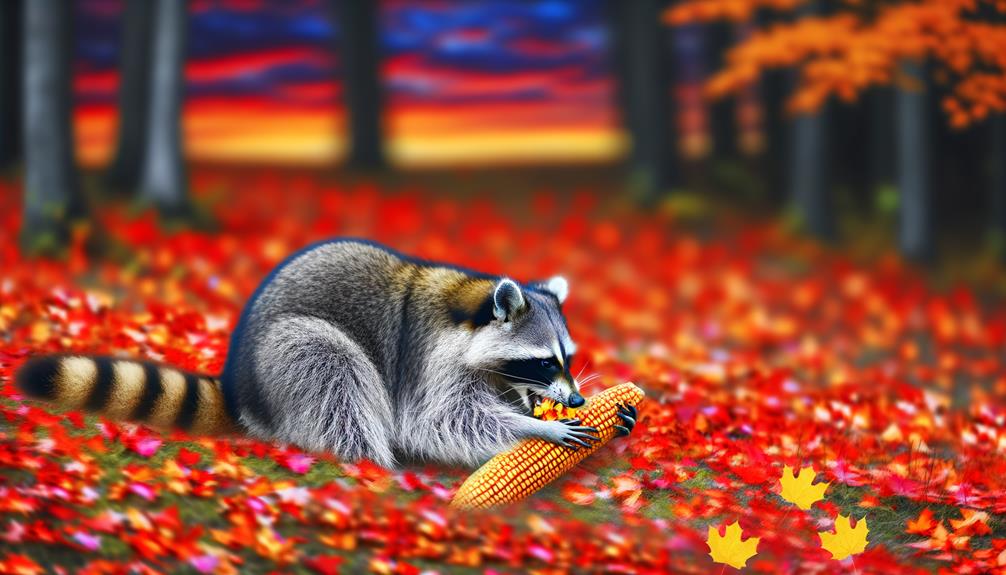
Raccoons' feeding habits demonstrate significant variation throughout the year, influenced by seasonal changes in food availability and environmental conditions.
In spring, raccoons primarily consume insects, small vertebrates, and newly sprouting vegetation.
As summer progresses, they diversify their diet to include fruits, berries, and field corn, which becomes increasingly accessible.
During autumn, raccoons focus on high-calorie foods like nuts and acorns to build fat reserves for winter.
In winter, their activity levels decline, and they rely on cached food and any remaining accessible resources.
This seasonal adaptability guarantees raccoons can exploit various food sources as they become available, demonstrating their opportunistic and omnivorous nature.
Understanding these patterns is essential for managing raccoon interactions with agricultural practices and natural ecosystems.
Nighttime Foraging Behavior
Frequently observed under the cover of darkness, raccoons exhibit pronounced nocturnal foraging behavior that maximizes their access to food while minimizing the risk of predation. This behavior is characterized by several distinct patterns:
- Enhanced Sensory Perception: Raccoons utilize their highly developed sense of touch and night vision to locate food sources.
- Opportunistic Feeding: They exhibit flexible dietary habits, readily consuming available resources, including field corn.
- Stealth and Caution: Raccoons move quietly and cautiously to avoid detection by predators and humans.
- Social Interactions: While primarily solitary foragers, raccoons may occasionally forage in small groups, increasing their efficiency in locating food.
Understanding these nocturnal foraging behaviors provides insight into raccoons' survival strategies and ecological roles.
Impact on Cornfields
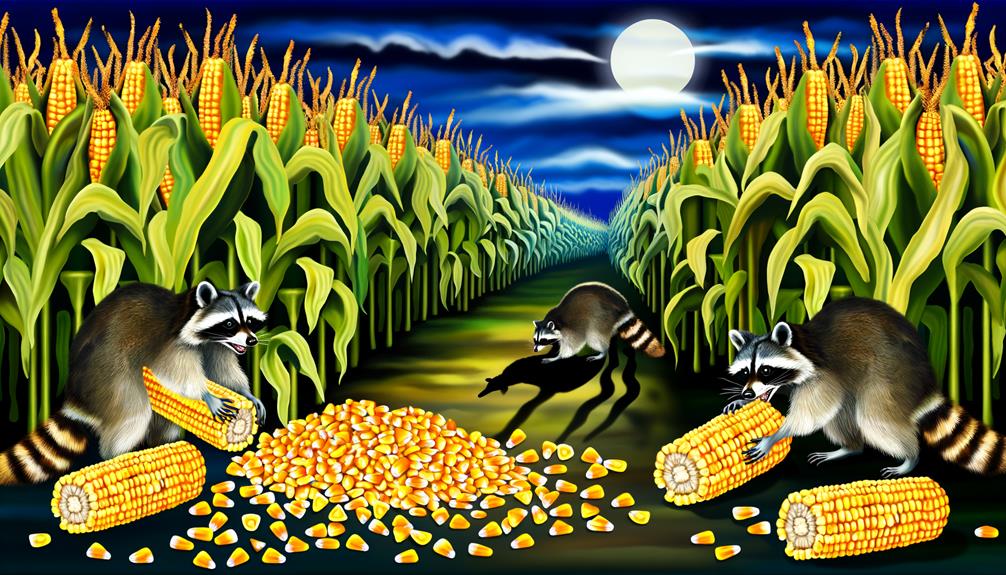
The presence of raccoons in cornfields can lead to significant crop damage, as their foraging activities often result in the physical destruction of corn plants and the consumption of kernels. Raccoons typically target corn during its milk stage, when kernels are tender and sugary. This preference results in substantial losses, as a single raccoon can damage multiple stalks in one night.
The compromised structural integrity of the plants can further exacerbate the issue, leading to reduced yields. Additionally, raccoons can trample surrounding vegetation while moving through the fields, causing collateral damage. The economic impact on farmers can be considerable, necessitating the implementation of effective management strategies to mitigate these losses and protect the viability of corn crops.
Identifying Raccoon Damage
Identifying raccoon damage in field corn involves observing specific signs and patterns. Common indicators include trampled stalks, partially eaten ears of corn, and the presence of raccoon tracks or droppings near the affected areas.
Additionally, raccoons often leave behind husks and cobs scattered around the site, providing further evidence of their activity.
Signs of Raccoon Presence
When examining a field of corn for signs of raccoon presence, detailed observations of the damage patterns are essential for accurate identification. Raccoons often leave behind specific indicators that can be distinguished from other wildlife.
- Footprints: Raccoon tracks are identifiable by their five-toed prints, which resemble tiny human hands.
- Droppings: Raccoon scat is typically cylindrical, dark, and may contain undigested corn kernels.
- Flattened Areas: Raccoons tend to trample plants as they navigate, creating noticeable flattened paths.
- Partially Eaten Ears: They often strip the husks and eat the kernels, leaving behind partially eaten cobs.
Recognizing these signs can help farmers and researchers accurately determine raccoon activity within cornfields, facilitating targeted management strategies.
Damage Patterns Observed
Recognizing damage patterns caused by raccoons is essential for distinguishing their activity from other wildlife in cornfields. Raccoons typically exhibit selective feeding behavior, targeting specific ears of corn. Unlike deer, which may graze uniformly, raccoons often strip husks and consume kernels directly from the cob, leaving partially eaten ears.
In addition, raccoon damage is often localized near the ground, as they pull down stalks to access the corn. Observers may note claw marks on husks and cobs, indicative of raccoon's dexterous forepaws. Moreover, raccoons tend to create feeding sites with multiple damaged ears concentrated in one area.
Identifying these distinct patterns helps in accurately attributing damage to raccoons and implementing appropriate management strategies.
Deterring Raccoons From Corn
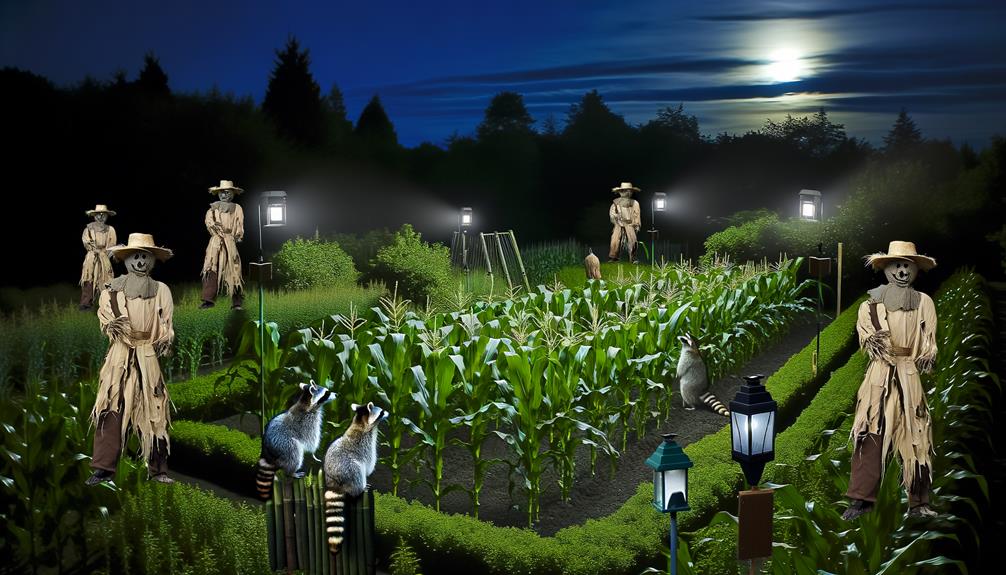
To effectively deter raccoons from field corn, several strategies can be implemented based on scientific observations. These include:
- The installation of sturdy fencing and barriers
- The application of natural repellents
- The use of motion-activated devices that startle and discourage raccoon activity
Each method offers unique benefits and challenges, requiring a detailed understanding of raccoon behavior and environmental considerations.
Fencing and Barriers
Effective fencing and barriers serve as essential deterrents in protecting field corn from raccoon predation. Utilization of appropriate physical barriers can notably reduce crop damage by these nocturnal foragers. Fencing options vary in complexity and cost, ensuring solutions for diverse agricultural needs.
Electric Fencing: Utilizes a mild electric shock to discourage raccoons from climbing.
Hardware Cloth: A durable mesh that can be buried underground to prevent digging.
Polywire Fencing: Lightweight and easy to install, providing a non-lethal deterrent.
Barrier Plants: Thorny or dense vegetation can create a natural barrier, albeit less reliable.
These methods, when properly implemented, enhance the protection of field corn, ensuring both economic and food security for farmers.
Natural Repellents Usage
While physical barriers provide a substantial defense, the application of natural repellents offers an additional layer of protection against raccoon predation on field corn. Research indicates that certain substances can act as effective deterrents.
For instance, capsaicin, derived from chili peppers, creates an unpleasant sensation for raccoons, discouraging their consumption of treated crops.
Additionally, predator urine, such as that from foxes or coyotes, can exploit raccoons' natural fear response, reducing their presence.
Another method involves using garlic or onion sprays, which emit strong odors that raccoons find repellent.
These natural repellents, when applied consistently and correctly, can notably diminish raccoon activity in cornfields, thereby safeguarding yields without resorting to chemical interventions.
Motion-Activated Devices
In addition to natural repellents, motion-activated devices provide a technologically advanced strategy to deter raccoons from field corn. These devices leverage sensors to detect movement and trigger responses that discourage raccoon activity. Their effectiveness stems from the immediate and unexpected nature of their activation, which startles the animals and discourages further intrusion.
- Ultrasonic Emitters: Emit high-frequency sounds that are disturbing to raccoons but inaudible to humans.
- Water Sprayers: Utilize a burst of water to startle and repel raccoons upon detection.
- Light Flashers: Flash bright lights to disorient and scare away nocturnal animals.
- Sound Alarms: Produce loud noises that mimic predators or other threats to raccoons.
These devices offer a non-lethal, environmentally friendly method to protect field corn.
Alternative Food Sources
Raccoons exhibit a highly adaptable diet, often turning to alternative food sources such as fruits, nuts, insects, and small vertebrates when field corn is unavailable. Their omnivorous nature allows them to exploit a wide range of nutritional options depending on seasonal availability and environmental conditions.
For instance, during autumn, raccoons frequently consume acorns and other nuts, while in spring and summer, they might focus on berries and various insects. They are also known to forage for amphibians, small mammals, and bird eggs, demonstrating their opportunistic feeding behavior.
This dietary flexibility not only aids in their survival but also enables them to thrive in diverse habitats, from urban environments to rural farmlands.
Coexistence Strategies
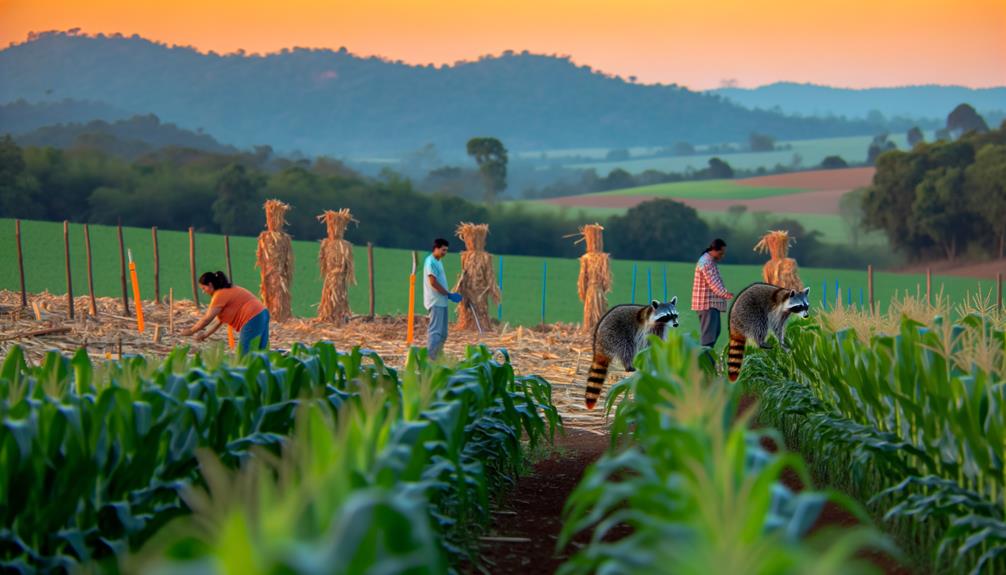
To effectively manage their interactions with human agricultural practices, raccoons employ various coexistence strategies that minimize conflict while maximizing their access to diverse food sources. These strategies are integral to their survival and adaptability in diverse environments. Observations reveal several adaptive behaviors that raccoons utilize to navigate agricultural landscapes without causing significant disruption.
- Nocturnal Foraging: Raccoons primarily forage at night, reducing direct encounters with humans.
- Dietary Flexibility: They consume a wide variety of foods, from insects to fruits, reducing dependence on any single crop.
- Habitat Utilization: Raccoons use natural cover such as forests and waterways near fields to remain concealed.
- Opportunistic Feeding: They exploit available food sources, including leftovers and waste, which decreases the need to raid crops.
Wildlife and Agriculture Balance
Achieving a sustainable balance between wildlife presence and agricultural productivity requires a nuanced understanding of the intricate interactions and mutual impacts within these ecosystems. Farmers must recognize that wildlife, such as raccoons, play a significant role in the ecological landscape.
Raccoons, while often seen as pests, contribute to seed dispersal and pest control, which can benefit crop health. However, their foraging on field corn can result in economic losses. Implementing integrated pest management (IPM) strategies, which include habitat modification, exclusion techniques, and population control, can mitigate these impacts.
Research indicates that a combination of these methods is most effective in reducing crop damage while maintaining ecological integrity. Balancing these aspects is essential for both agricultural success and biodiversity conservation.
Conclusion
In the grand tapestry of nature, raccoons act as both the weavers and the threads, intricately linked to the fields of corn they so fervently seek.
Their dietary preferences underscore a broader narrative of survival and adaptation, creating a delicate interplay between wildlife and agriculture.
Understanding these dynamics fosters strategies for harmonious coexistence, ensuring that the needs of raccoons and the imperatives of farming can be balanced with scientific precision and ecological empathy.


